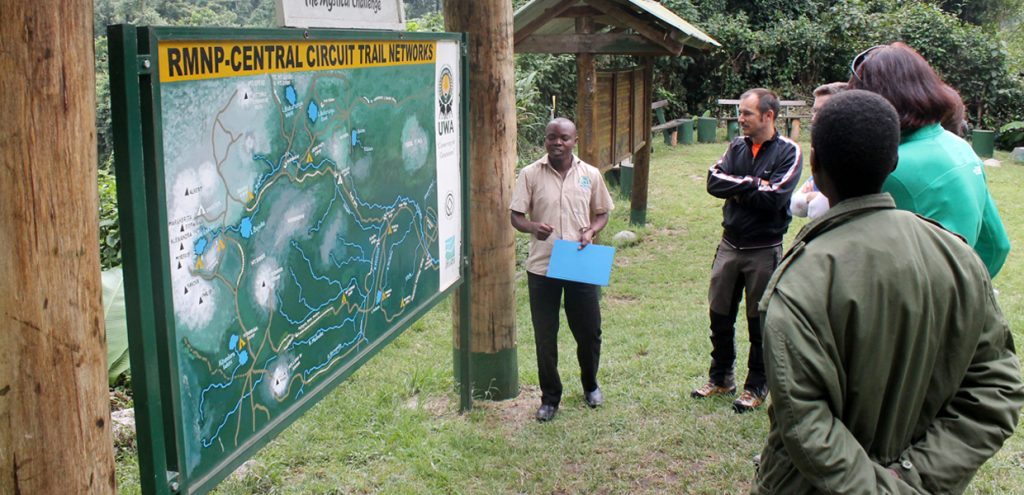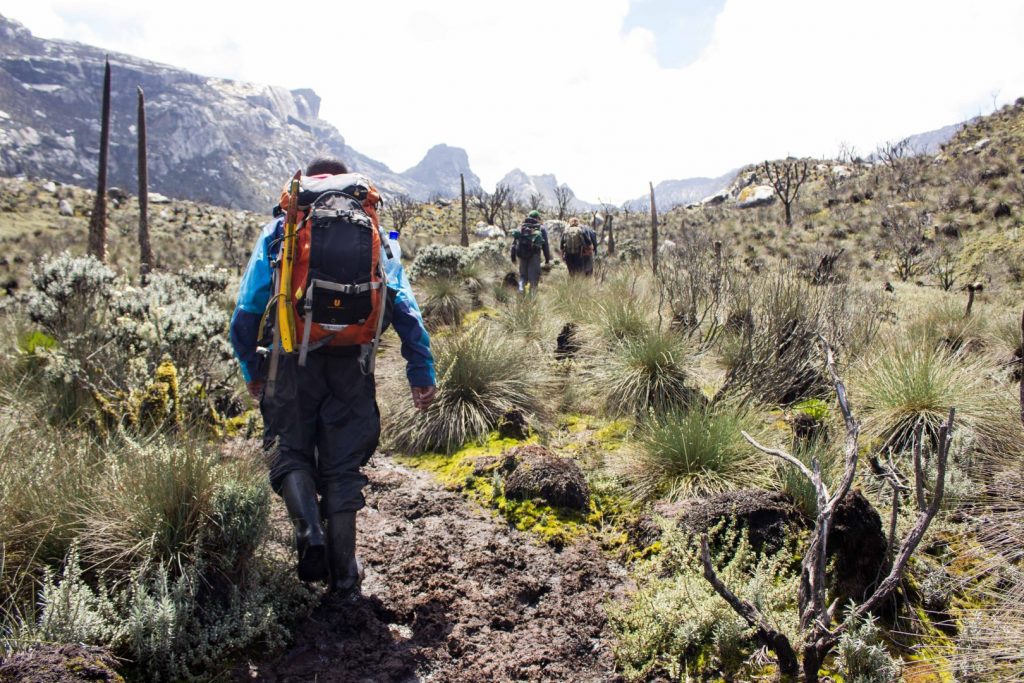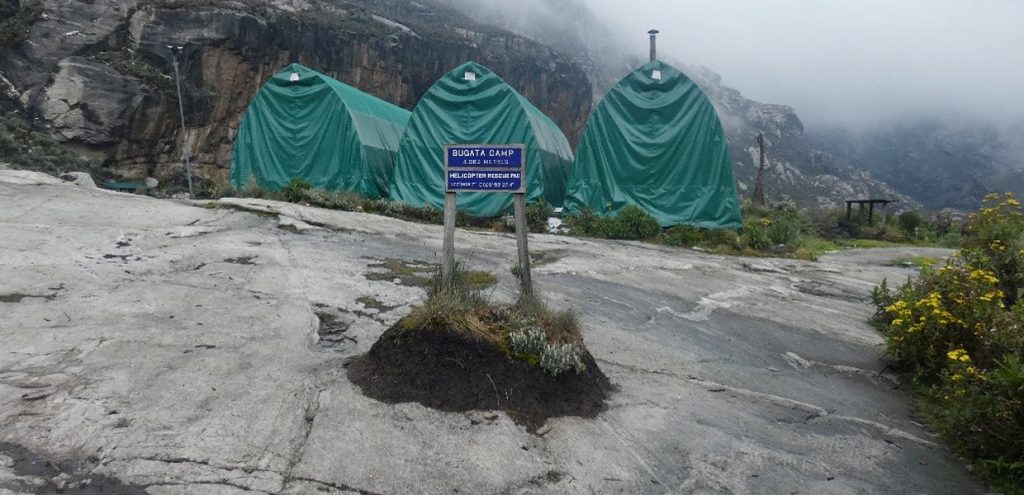Are you planning for Rwenzori Mountain hiking, getting you up to Weismann’s peak at 4,620m and Stella peak at 4,626m? This 6 days Rwenzori mountain hiking adventure covers you as a mountain climber looking for a great hiking experience in Uganda. While on this adventure expect great excellent views of the four lakes along the valleys.

Getting to the peak is steep on solid rock and can be difficult when snowing or iced up and it may be necessary to use ropes for safety. On a clear day, you get fantastic views of all the main peaks; Mt Stanley, Mt. Speke and Mt. Baker. The top of Weismann’s peak is relatively flat or dome shaped with deep moss growing on the rocks which create a beautiful atmosphere.
Rwenzori Mountain hiking in Uganda is such memorable experience especially when you book with us.
Rwenzori Mountain Hiking Itinerary:
Day 1: Kampala – Kasese
Arrival at Entebbe airport by morning flight. Transfer to Kasese via Mbarara for lunch at the Agip Motel in Mbarara town. From here, the landscape changes to a hilly and fertile area with tea and banana plantations.
Dinner and overnight stay at Hotel Margherita. Meal Plan: Lunch and dinner
Day 2: First Day Trek on Rwenzori Mountain Hiking
The trek starts at Trekkers Hostel in Kyanjuki, which is situated 1,450 meters above sea level and 12 kilometers from Kasese town. It is best to start by 9:00am but you can leave not later than 11:00am. You will walk for 2.2km to Uganda Wildlife Authority rangers’ post at 1,727 meters, which takes about one hour. Here, you will pay the gate entrance fee and then the rangers will brief you on the rules of the national park and the trekking adventure.
We start by walking up the valley floor through tall forest trees of the Afro-montane forest zone. This is a steady climb with multitudes of birds and a chance of seeing wild chimpanzees or blue monkey scampering off through the forest. At times visitors may see troops of 15 to 20 colobus monkeys scampering through the tree tops. There are rare sightings of the L’Hoest monkey which are part of the Bukonzo cultural emblems and are protected by the virtue of the King (Omusinga).
There is wide variety of plant species, ranging from forest trees to bamboos thickets, low shrubs, flowers and fungi. Most of them with moss and lichen covered vines hanging from the tall trees, which creates an awesome appeal. Enock’s Falls are just 200 meters from Sine Hut and offer a splendid opportunity to capture a great screensaver for your memories.

Steadily walk with a steep climb for a few kilometers, then continue trekking to 1,450 meters reaching at Sine Hut at 2,596 meters, which is a height gain of 1,146 meters. For those who want a bigger challenge on the first day, they are welcome to continue to Kalalama Camp at 3,147m. This will give them ample time to climb Mutinda Lookout at 3,975 metres in the afternoon to enjoy the views. As a result, this gives a better acclimatization for the trek, while reaching Mutinda Camp at 3,688 metres.
Besides, the wooden Sine hut has 10 beds set between tall forest trees on a narrow ridge. The camp also has a large verandah where you may sit and enjoy the beauty of the Afro Montane forest, while looking down at a fantastic waterfall crashing over the rocks far below. Sine is just below the bamboo zone and the area around has many different bird species. Sleep at Sine Hut – 2,585 metres.
Day 3: Third Day Trek
After a good breakfast, trekking starts at 8.30am and you soon enter the Bamboo-Mimulopsis zone which is a steep climb with many high steps. During wet seasons the bamboo area is rather muddy and slippery making the trekking slow. However, the atmosphere and the forest is beautiful as you climb to a 551 metres altitude within a distance of 1.8km to Kalalama camp at 3,147 meters.
Kalalama camp is in the Heather-Rapanea zone where you can take a rest and a quick cup of tea or coffee before heading onto Mutinda camp. The trail meanders up and over several small knolls along a ridge top then drops down to the side of the valley, before climbing again. In doing so, you will cross several small streams passing close to moss covered waterfalls.
You will then climb steadily along the side of a beautiful mossy river which tumbles down over the rocks under giant heather trees. The trunks of these trees are covered in green moss with old man beards (Usnea lichen) hanging from the branches.
The trail then twists and turns as you climb up the deep valley, which has an enormous variety of plants and flowers. This valley is unique with many giant heather trees, which create a beautiful atmosphere often shrouded in the mist.
Eventually you will get to Mutinda Camp which is set near a small river that drops off a waterfall while offering a chance to wash, refresh and relax. You may wish to climb up to the top of Mutinda Lookout (one and a half hours up and one hour down). The view and the atmosphere here is amazing as you stand on moss covered rocks at 3,925 meters with views across the Rwenzori Mountains, down to Kasese town and Lake George.
Note: During the summer of 2011/2012, from December to late March, there was a unprecedented dry spell and a large fire burnt across much of the alpine area of the Rwenzori Mountains. Fortunately, due to the high rainfall, the vegetation is recovering and the mosses are again growing on the rocks and cliff faces.
The worst affected area is above Kiharo Camp where there was a large forest of giant heather trees. These are now blackened sticks. However, the area still holds a beauty with towering cliffs and small areas unaffected by fire along the valley floor. These have deep green fresh shoots and vegetation, which bring new life to the mountains. All of the tussock grass and giant groundsel have regrown and the malachite sunbirds are feeding on the flowers of the giant lobellias.
Kiharo camp has been moved below the burnt area and is particularly beautiful with many birds, animals, rock hyrax and several species of rare chameleons. Some of these species have been found living at altitudes of 3,650 metres. The affected areas are between Mutinda and Bugata camps approached on day 3 and on the way down from Bugata Camp to Kiharo Camp. However, the area is recovering much quickly than expected, due to the high rainfall since then.
Day 4: Forth Day Trek – 4.9km Starting at 3,688m climbing to 4,062m

The trail here is boggy particularly during wet seasons but with a little skill you can step from tussock to tussock to make the going easier. You will cross the Mutinda valley through the tussock grass and everlasting flowers interspersed with many giant lobelias, before climbing a steep section up to the Namusangi Valley (3,840 meters). This ends abruptly with sheer waterfalls and fantastic views of Mutinda peaks.
The Namusangi Valley is wide, with many ups and downs, crossing several bogs as the trail climbs steadily to Bugata Camp at 4,062 meters. Bugata Camp is situated way up Bamwanjara pass high above Bugata Lake with views across Lake Kopello to Weismann’s peak. The camp is often covered with snow but with views of Lake Africa and Lake Kanganyika and the many small peaks towards Mutinda Camp, down the valley.
The area is covered with tussock grass, everlasting flowers (Helichrysum), St John’s Wort (Hypericum becquaeritii), giant groundsel (Senecio adnivalis) and giant lobelia (Lobellia gibberoa). There are a many Red forest duikers (Cephalophuc nigrifrons rubidus) which are a sub-species only found in the Rwenzori Mountains. In the past they have been very hard to see due to the thick vegetation, but after the fire that burnt across the alpine region of the Rwenzori Mountains, they are now easier to see in the new shorter growth.
In the dryer season you may choose to walk directly up the valley but a more scenic trail meanders along the hilltops with fantastic views of Lake Nusuranja from Plozza Rock. From Plozza Rock, you will also get fantastic views down the valley of nine lakes ringed by rugged peaks and ridges.
Bugata Camp has good facilities, solar lights, good toilets and bathrooms where the guides may prepare some warm water in a basin for you to wash. Bugata also has a heli pad (GPS reading N 18.312 E29 53.457) in case of any need for rescue by helicopter.
Day 5: Fifth Day Hike – Climb Weismann’s Peak 4,620m and Stella Peak 4,626m
Take 3.7km to Weismann’s Peak, then another 800 metres to Stella Peak and return. There is a total distance of 9km, which takes about 4 to 6 hours. The trek starts by walking across the hillside below high cliffs above Bugata Lake, then around a ridge point to Lake Kopello.
You will then walk along the edge of the lake whose water temperatures, according to researchers, averages 2˚C. As you climb, you get excellent views of the four lakes along the valley below. The last section to the peak is steep on solid rock and can be difficult when snowing or iced up and it may be necessary to use ropes for safety. On a clear day, you will get fantastic views of all the main peaks; Mt. Stanley, Mt. Speke and Mt. Baker.
The top of Weismann’s Peak is relatively flat or dome shaped with deep moss growing on the rocks, which creates a beautiful atmosphere. For those who want to climb to the highest point, you can take a gentle walk across the moss covered domed-shaped ridge to Stella Peak 4,626 metres.
You will then return to Bugata Camp and sleep at Bugata Camp.
Day 6 – Descend to either Kiharo Camp (3,460m) or Samalira Camp (3,170m)
Early in the morning you will set off around Lake Bugata to the outlet of Kopello Lake, then climb 200 metres to the confluence of the two valleys. As you descend down the upper areas of the Nyamwamba Valley there is a large area of thick giant groundsel, with dense evergreen undergrowth and moss with the rocky peaks towering above.
As you descend the valley, you will notice the terrain is made up of several flat boggy areas where glaciers sat millions of years ago and then melted, leaving a wall of big rocks in front where it lay. The valley is home to many Red Forest Duikers (Cephalophuc nigrifrons rubidus). At night, you may stay in Kiharo Camp at 3,460 metres, an area rich in evergreen plants and babbling streams. The air is filled with calls of the rock hyrax as they sit in the rocky cliffs high above.
Note: It is necessary to skip one of the camps, you may either stay in Kiharo and enjoy the lush vegetation and rocky cliffs or may descend to Samalira Camp at 3,170 meters making a shorter trek down to the base camp the following day.
Assuming that you slept in Kiharo Camp, you wake up to the shrill calls of the Ruwenzori Turaco (Ruwenzorornis johnstoni) and other bird species. After a hearty breakfast, you will walk down the valley which is home to many species of birds diving in and out of the thick vegetation. Chameleons are a common sight as they crawl along the branches of the thick vegetation, feeding on insects.
In clear areas you may catch a glimpse of duikers quietly feeding, surrounded by giant lobellias and a variety of flowering plants.
After descending a few kilometres, you will climb a height of about 200 metres to a ridge overlooking the valley before crossing several small valleys and streams to ‘Kyalavula’. This means view or lookout in local Bakonzo language. So, you will get beautiful views down the valley and across to Lake Edward in Queen Elizabeth National Park.
Samalira Camp (3,147m) is situated in a closed valley at the top of several waterfalls and it is the alternative to sleeping in Kiharo Camp. From here, you will descend down a long ridge, through the Bamboo-Mimulopsis zone and Afro-montane forest zone. Thereafter, be transferred back to Kampala or Entebbe for your departure flight back home or your next destination. Meal Plan: B & L.
Besides Rwenzori Mountain, other mountain climbing tours in Uganda are provided on Mount Elgon along the Uganda – Kenya border, the Virunga Mountains that run across Uganda, Rwanda and DRC, Mount Moroto, Kadam and Morungole in the Karamoja sub-region within north-eastern Uganda.
Rwenzori Mountain Hiking Adventure Inclusions and Exclusions:
Includes
- Accommodation and meals during the hike
- All ground transfers with 4wd vehicle as per the itinerary
- Park Entrance fees
- Professional Guide fees
- Porters 25kg per person
- Professional cook
- Rescue fees in case of emergency rescue on Rwenzori Mountains
Excludes
- Flight fares
- Personal insurance
- Equipment for the hike
- Extra Luggage (extra 25kg per person)
- Any changes in the program itinerary while in the Rwenzori
Important to Climbers on Rwenzori Mountain Hiking:
- Climbers must be prepared to walk for up to 8 hours every day via steep cliff and muddy paths.
- Climbers must bring along their own climbing gear or hire it at the base camp.
- Our porters carry 8 kg of personal climbing gear
